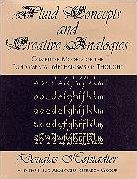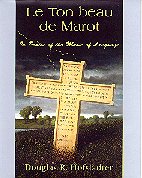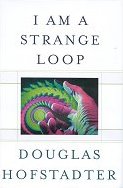Hofstadter's latest tour de force, executed with his
customary panache and élan, is all about
translating Clément Marot's 28-line, 84-syllable, 450-year-old
French poem "A une Damoyselle malade" into English.
"A novel all about a carpet?"
"Yeah, but only in the way The Lion, The Witch and
the Wardrobe is all about a cupboard."-- about Clive Barker's Weaveworld
on BBC TV's book review programme Cover to Cover.
1987
It is also a semi-autobiographical look at languages, linguistics,
poetry, pattern, music, puns,
playfulness, constraints, creativity, cognition, culture, AI, life, love
and death.
How do you translate poetry between languages, between cultures? Should
you strive for a literal translation, sacrificing rhyme and metre to get
across the exact semantics? Or should you "try harder", and
capture the music as well as the meaning? Hofstadter falls firmly in the
second camp: poetry's "esthetically restricted medium" forms an
essential part of the message, and by not translating the medium,
you lose that essential part. He doesn't reserve his distaste just for
rhyme-less, metre-less translations; he's not that keen on
original works in blank verse, either:
... In such works I perceive neither a clear message nor a clear
medium, and certainly not an esthetically pleasing medium. What I do see
without difficulty is streams of obscure language punctuated by unexpected
line-breaks. The poet would supposedly be conveying to us some marvelous
exquisite sensitivity for language and life by determining where carriage
returns fall in what otherwise is a piece of largely incomprehensible, self-
indulgent verbiage.
When the poet is writing the original composition, the constraints of
rhyme and metre can, paradoxically, help creativity. Being forced
to make a rhyme, or have a certain number of syllables, or a particular
stress pattern, can make the poet come up with a word or phrase that might
not have been thought of otherwise, which can in turn lead to new ideas.
The translator, however, is working under a double constraint,
because the source text is fixed, and rhymes found in the new language
have to reflect that. Some translators wimp out and use partial rhymes,
some, like Nabikov with Pushkin's Eugene Onegin, scorn any attempt
to translate the rhyme and metre, insisting that the meaning is all.
Hofstadter demonstrates time and again that such an approach is neither
necessary nor in any sense 'better', by exhibiting several different
translations of classic poems, many of which have managed to preserve the
music as well as the meaning.
TbdM isn't just about translating poetry. Hofstadter also
discusses translating prose, and how much the cultural context should also
be translated. This is not too difficult in technical prose, where there
is little such context. But what about novels? Should an incident be
translated 'literally', which might make the translated incident sound
unintentionally exotic, or into an 'equivalent' incident in the new
culture? And what if an incident is autobiographical? These questions are
illustrated with examples from translating Hofstadter's own GEB
into French and Chinese.
He also reckons that it could well be nigh on impossible to translate
TbdM itself. That's not due just to the fact that it is about
translation, and that there are snippets discussing English translations
of foreign poetry (how do you translate the translations?). TbdM
itself is 'poetry' in places, because of the medium constraints Hofstadter
imposes on himself. Some passages have rhyme and metre, some are written
without using a particular letter of the alphabet, some have a particular
internal structure, some are complicated puns on other parts, the first
words of each chapter are in a larger font so cannot have descenders; even
the layout on the pages is strictly controlled so that there are no ugly
page breaks in the middle of poem fragments. [When I quoted the passage
above, I forced the line-breaks to occur in the same places, respecting
Hofstadter's original choices; I didn't force a 'page break' after "marvelous",
however.]
England and America are two countries
divided by a common language.--George Bernard Shaw
(attr.)
TbdM is written in what I believed to be my native language. But
I had it made clear to me how much translation is about culture as well as
language from the very first sentence: "Picture Holden Caulfield all
grown up, now a university professor, writing a book about translation."
Holden who? I read on, hoping for clues, until I got to "This
sounds like poor, poor Salinger." Aha -- Salinger -- so it's a
literary reference then -- presumably Catcher in the Rye? Pull a
reference book off the shelf -- yes, Caulfield is the protagonist.
Apparently, Catcher in the Rye is deeply part of American culture,
one of those books nearly every American has read; but it's not part of
my, British, culture. I'm vaguely aware it's about American
teenage angst, but that's all. So the very first sentence doesn't
translate for me! Then, later on, we get to the phrase "topless
zoning laws" as an example of something a native reader would
obviously understand, but would take a long sentence, or even short
paragraph, of explanation to translate into any other language -- well,
I needed that explanation in order to translate it into my English.
I'm not a native speaker of my own language, it seems. So, this is rather
fascinating: I'm learning something from this book, where that 'something'
is what the book is all about, that a native speaker of American
English would not!
Hofstadter goes on to contrast the curious 'invisibility' of
translators, despite the enormous creativity and skill they bring to their
job, with the almost 'cult of the individual' of musical performers [and
conductors] where the identity of the original composer can definitely
play second fiddle. When we applaud wildly and shout encore, we
are asking for more from that performer, not more from that composer.
[Although I do remember once hearing an interview with a famous cellist,
where they said they preferred playing a particular concerto that wasn't
recognised as first rate (possibly a Saint-Saens concerto) because then
they knew any applause was for their performance, rather than for
the composer. (Since I recall neither the cellist nor the concerto,
obviously I'm using 'remember' in rather a loose sense here.)]
Hofstadter weaves his tales of translation into a story about human
cognition. Thinking about good translations can help us understand
some of the deep questions about cognitive patterns, about how we as
humans understand and create, and about whether computers could ever do
the same. There's yet another devastating attack on Searle's Chinese Room
argument -- by building a lovely mental image of the sheer scale of a real
such room, and the minute relative size of the human CPU in it. Yet he
also attacks the hype and over-simplicity of some AI researchers
'dictionary' approach to machine translation. These programs still show no
understanding of what they are translating, and so make ludicrous
errors. [My own litmus test for AI is when a computer can correctly
understand the newspaper headline SHELL FOUND ON BEACH,
and notice that it's funny. This requires not only common-sense
understanding, but 'meta-common-sense', to realise that the 'obvious
default' meaning here cannot possibly be the intended meaning.]
And there's much more, too. For the most part, because of Hofstadter's
playful style and wit, TbdM is a light-hearted read. But because
of the overshadowing fact of the death of his wife Carol, it is also
almost unbearably poignant in places.
Hofstadter thinks TbdM is the best book he's ever written.
Personally, I would have to disagree -- I still reserve that place for
GEB, which I found a sheer mind-blowing
experience. TbdM is more anecdotal, reflective and contemplative,
and I didn't feel I came away with my paradigms quite so severely shifted.
(Or maybe that says more about me and the passage of nearly 20 years
between reading the two?) But second best from Hofstadter is still streets
ahead of much of the competition.






